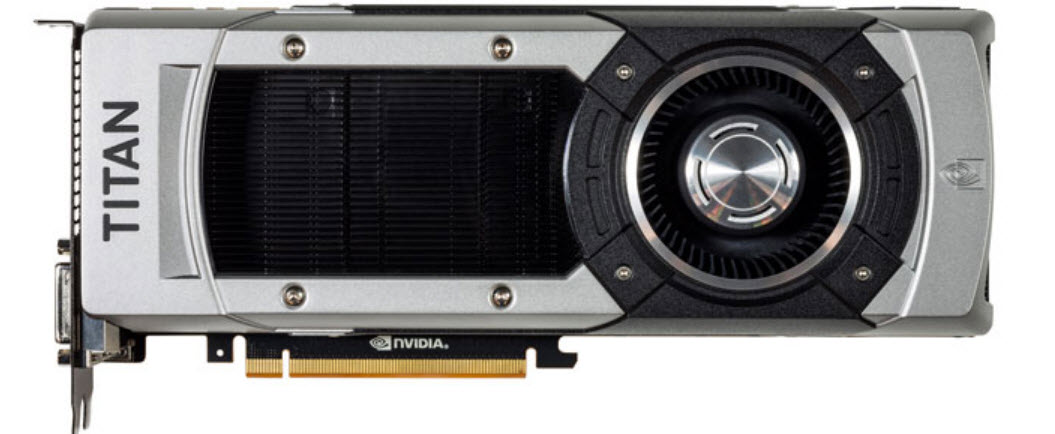Nvidia GeForce GTX Titan Black Has Fully-enabled GK110 Core
Nvidia's Titan Black has been announced, finally giving us a Titan with a fully-enabled GK110 core.
Nvidia has launched its GTX Titan Black graphics card. The GTX Titan Black is a GK110-based graphics card, similar to the original GTX Titan, but rather with a fully-enabled GK110 core.
The fully-enabled GK110 core features all 15 SMX units enabled, making for a CUDA core count of 2880 cores.
Nvidia has equipped the card with a base GPU clock speed of 889 MHz, while it has a Boost 2.0 frequency of 980 MHz. On the card users will find 6 GB of GDDR5 memory, accessed over a 384-bit wide memory interface, and running at an effective speed of 7.0 GHz. The card will still carry the same 250 W TDP.
The specifications of the card might appear to resemble the GTX 780 Ti, however, the Titan cards carry double the amount of graphics memory, and have a much higher double-point precision performance. This makes the card more interesting to developers rather than gamers, as for gamers there would be little-to-no benefit, while it will cost more. Therefore, Nvidia has also not sent out units for reviewing, as gaming results would be almost identical to that of the GTX 780 Ti.
Cooling of the card is achieved by Nvidia's NVTTM cooler, but rather than the text showing GTX 780 Ti, it will simply read TITAN. To distinguish the GTX Titan Black from the original GTX Titan, you'll have to look for the black lettering as well as the black fin array under the Plexiglas cover.
The card will come to shelves soon, and will carry an MSRP price of $999.
Get Tom's Hardware's best news and in-depth reviews, straight to your inbox.
Niels Broekhuijsen is a Contributing Writer for Tom's Hardware US. He reviews cases, water cooling and pc builds.
-
colinstu ReplyDoes this mean the price for the regular titan will be reduced?
It means the price of the old one will stay the same until all inventory of it is gone. Try finding one online... very little stock of it is left anyway. -
renz496 Reply12708494 said:Does this mean the price for the regular titan will be reduced?
no. this will replace the original titan directly. -
lancelot123 Reviews for us gaming in 4K and 5760x1200 would be nice. Especially with the games that use more than 3GB at those resolutions with AA cranked up.Reply -
Blahman11 Will we see people flashing GTX 780ti's into Titan Blacks when someone gets hold of the card bios? Happened with the GTX 680 am I right?Reply -
BranFlake5 @Blahman11 Why? It's literally just a 780 TI 6GB. I don't think the Titan supports workstation card drivers so it's no use. Also, I think it was actually a 690 to a k5000. Please Correct me if I'm wrong, but there is absolutely no reason to flash a 780ti into a Titan.Reply -
dragonsqrrl Reply@Blahman11 Why? It's literally just a 780 TI 6GB. I don't think the Titan supports workstation card drivers so it's no use. Also, I think it was actually a 690 to a k5000. Please Correct me if I'm wrong, but there is absolutely no reason to flash a 780ti into a Titan.
To unlock the FP64 performance.
I mentioned this in a previous thread, but I'm really surprised there hasn't been more discussion about unlocking the 780/780 Ti using custom firmware.
Not sure how a 690 would be flashed to a K5000 -
BranFlake5 Reply12710738 said:@Blahman11 Why? It's literally just a 780 TI 6GB. I don't think the Titan supports workstation card drivers so it's no use. Also, I think it was actually a 690 to a k5000. Please Correct me if I'm wrong, but there is absolutely no reason to flash a 780ti into a Titan.
To unlock the FP64 performance.
I mentioned this in a previous thread, but I'm really surprised there hasn't been more discussion about unlocking the 780/780 Ti using custom firmware.
Not sure how a 690 would be flashed to a K5000
Read This
And how can the 780's support double-point-precision? Is that a firmware or hardware feature?

